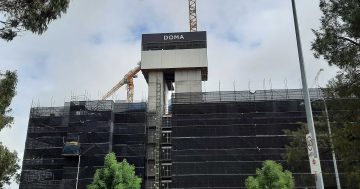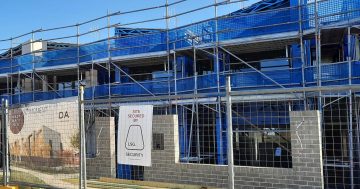
Sustainable Building and Construction Minister Rebecca Vassarotti says defects will be picked before and during builds, but will a four-person team be enough? Photo: Ian Bushnell.
The ACT Government’s announcement of a new quality assurance team within Access Canberra to prevent construction defects in the residential building industry sounded almost plausible until it confirmed that only four members would be recruited over the next year.
That doesn’t seem anywhere near the number necessary to do the job – from documentation through construction to overseeing private certifiers’ final sign-off on projects.
It was in 2020 that the government pledged to bring the certification process back into public hands to eliminate any conflicts of interest; that is, the alleged cosy relationships between private certifiers and developers that allowed defects to be overlooked.
Four years later, after consultation/lobbying, the private certifiers remain, but this new team will be looking over their shoulders to make sure nothing is missed.
They’ll also be poring over the plans to pick up problems that can be designed out and inspecting sites as they go to spot issues before they are baked in.
All well and good.
However, there are real questions about whether this small team will have the capacity or the teeth to turn around the seemingly endemic nature of defects, especially in the multi-unit sector, which will be its first area of focus.
Will it be a genuinely new and independent team or just an extension of Access Canberra’s current regulatory functions?
People will also be wondering why ACT Planning and the National Capital Design Review Panel aren’t already picking up all the design issues and whether adding another layer of scrutiny will lead to more delays and cost overruns.
It seemed the government had acknowledged that the private certification system was broken, or at least impractical in the small commercial environment they inhabit.
Yet, they will survive. Sustainable Building and Construction Minister Rebecca Vassarotti insists private certifiers will have nowhere to hide if they don’t do the right thing, but does that mean the new team will need to approve every sign-off? And what powers will it have to hold certifiers to account?
The new approach reeks of a compromise to placate industry and consumers.
One of the biggest complaints from consumer groups such as the Owners Corporation Network is that during construction, architect’s designs or engineer’s instructions are modified to trim costs, introducing problems into the build.
It argued for some continuity of involvement from these professions on site so project integrity is retained.
Conversely, builders often say they followed the plans, and that’s where the blame should lie.
Either way, the proposed site inspections throughout construction are welcome if the team won’t be too stretched.
Sometimes outside of a developer’s and builder’s control is the quality of certain trades and subcontractors in critical areas, such as roofing and waterproofing, neither of which are licensed in the ACT.
Given water leakage is a major defect issue, this seems ridiculous.
Master Builders ACT has been campaigning for years to bring such work into the regulatory tent.
Townhouse and apartment developments are complex projects, and it is acknowledged that any number of things can go wrong.
Reputable builders say it’s not that mistakes won’t be made but how they are dealt with that matters.
But for too long, owners, who are paying large sums for their new homes, too often end up facing extra, sometimes crippling costs to repair major defects through body corporate levies after the developers have taken their money and moved on to the next project.
The government will be hoping the public will take confidence from the announcement, along with its other industry reforms, but results will be the only way for that to happen.





















